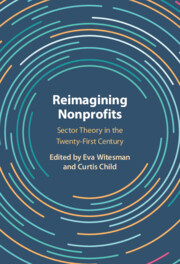Book contents
- Reimagining Nonprofits
- Reimagining Nonprofits
- Copyright page
- Contents
- Figures
- Tables
- Contributors
- Acknowledgments
- 1 An Invitation to Rethink the Nonprofit Sector
- Part I Overviews
- 2 An Overview of Nonprofit Sector Theories
- 3 The Prevalence of Traditional Nonprofit Sector Theories in Research
- 4 What Makes Good Nonprofit Sector Theory?
- Part II Reflections and Refinements
- Part III New Directions
- Part IV Conclusion
- Index
- References
2 - An Overview of Nonprofit Sector Theories
from Part I - Overviews
Published online by Cambridge University Press: 11 January 2024
- Reimagining Nonprofits
- Reimagining Nonprofits
- Copyright page
- Contents
- Figures
- Tables
- Contributors
- Acknowledgments
- 1 An Invitation to Rethink the Nonprofit Sector
- Part I Overviews
- 2 An Overview of Nonprofit Sector Theories
- 3 The Prevalence of Traditional Nonprofit Sector Theories in Research
- 4 What Makes Good Nonprofit Sector Theory?
- Part II Reflections and Refinements
- Part III New Directions
- Part IV Conclusion
- Index
- References
Summary
The chapter introduces readers to the major theories of the sector. Those covered include: market-failure theory, government-failure theory, contract-failure theory, voluntary-failure theory, supply-side (or entrepreneurship) theory, social-origins theory, interdependence theory, the commons, mediating structures, and associationalism.
Keywords
- Type
- Chapter
- Information
- Reimagining NonprofitsSector Theory in the Twenty-First Century, pp. 17 - 40Publisher: Cambridge University PressPrint publication year: 2024



